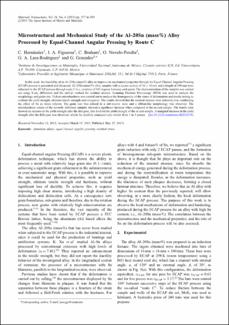| dc.contributor.author | Hernández, Cecilio | |
| dc.contributor.author | Figueroa, I. A. | |
| dc.contributor.author | Braham, C. | |
| dc.contributor.author | Novelo-Peralta, O. | |
| dc.contributor.author | Lara-Rodríguez, G. A. | |
| dc.contributor.author | González, G. | |
| dc.date.accessioned | 2017-08-09T18:50:45Z | |
| dc.date.accessioned | 2017-08-09T18:50:45Z | |
| dc.date.available | 2017-08-09T18:50:45Z | |
| dc.date.available | 2017-08-09T18:50:45Z | |
| dc.date.issued | 2013-05-25 | |
| dc.date.issued | 2013-05-25 | |
| dc.identifier.uri | http://ridda2.utp.ac.pa/handle/123456789/2528 | |
| dc.identifier.uri | http://ridda2.utp.ac.pa/handle/123456789/2528 | |
| dc.description | In this work, the feasibility of an Al–20Sn (mass%) alloy to improve its mechanical properties through the Equal Channel Angular Pressing (ECAP) process is presented and discussed. Al–20Sn (mass%) alloy samples with a square section of 16 × 16 mm and a length of 100 mm were subjected to the ECAP process through route C (i.e., rotation of 180 degrees between each pass). The characterization of the samples was carried out using X-ray diffraction and the sin^2(ψ) method for residual stresses. Scanning Electron Microscopy (SEM) was used to analyze the morphology and grain size. Vickers microhardness was carried out to analyze the homogeneity of the states of deformation and tensile testing to evaluate the yield strength, ultimate tensile strength and elongation. The results showed that the residual stresses were relatively low, confirming the effect of Sn as stress reliever. The grain size was refined to a sub-micron scale and a ribbon-like morphology was observed. The microhardness values of the severely deformed samples showed a significant increase when compared to the as-cast sample. The tensile tests showed an increase in the yield strength after the first pass, that doubled the yield strength of the as cast sample. A marginal increase in the yield strength after the fifth pass was observed; whilst the ductility remained very similar from 1 to 5 passes. | en_US |
| dc.description.abstract | In this work, the feasibility of an Al–20Sn (mass%) alloy to improve its mechanical properties through the Equal Channel Angular Pressing (ECAP) process is presented and discussed. Al–20Sn (mass%) alloy samples with a square section of 16 × 16 mm and a length of 100 mm were subjected to the ECAP process through route C (i.e., rotation of 180 degrees between each pass). The characterization of the samples was carried out using X-ray diffraction and the sin^2(ψ) method for residual stresses. Scanning Electron Microscopy (SEM) was used to analyze the morphology and grain size. Vickers microhardness was carried out to analyze the homogeneity of the states of deformation and tensile testing to evaluate the yield strength, ultimate tensile strength and elongation. The results showed that the residual stresses were relatively low, confirming the effect of Sn as stress reliever. The grain size was refined to a sub-micron scale and a ribbon-like morphology was observed. The microhardness values of the severely deformed samples showed a significant increase when compared to the as-cast sample. The tensile tests showed an increase in the yield strength after the first pass, that doubled the yield strength of the as cast sample. A marginal increase in the yield strength after the fifth pass was observed; whilst the ductility remained very similar from 1 to 5 passes. | en_US |
| dc.language | eng | |
| dc.language.iso | eng | en_US |
| dc.rights | https://creativecommons.org/licenses/by-nc-sa/4.0/ | |
| dc.rights | info:eu-repo/semantics/openAccess | |
| dc.subject | aluminum alloys | en_US |
| dc.subject | equal channel angular pressing | en_US |
| dc.subject | residual stress | en_US |
| dc.subject | aluminum alloys | |
| dc.subject | equal channel angular pressing | |
| dc.subject | residual stress | |
| dc.title | Microstructural And Mechanical Study of The Al-20Sn (MASS%) Alloy Processed By Equal-Channel Angular Pressing By Route C | en_US |
| dc.type | info:eu-repo/semantics/article | |
| dc.type | info:eu-repo/semantics/publishedVersion | |
